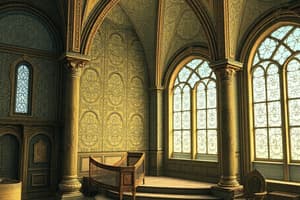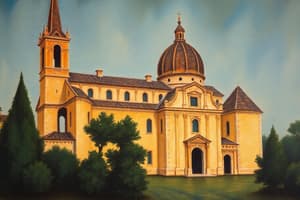Podcast
Questions and Answers
Relaciona los siguientes estilos artísticos con su descripción:
Relaciona los siguientes estilos artísticos con su descripción:
Estilo Románico = Caracterizado por figuras grandes que parecen salir de sus fondos, representa escenas bíblicas y caza. Estilo Gótico = Se desarrolló en Europa entre los siglos XII y XVI, caracterizado por la verticalidad y luminosidad en las construcciones. Estilo Renacentista = Surge en Italia en el siglo XIV, marcado por el realismo, proporción y perspectiva en las representaciones artísticas. Estilo Barroco = Predominante en el siglo XVII, se caracteriza por la ornamentación excesiva y la representación dramática de escenas. Estilo Neoclásico = Inspirado en la antigua Grecia y Roma, se enfoca en la simplicidad, equilibrio y armonía de las formas.
Relaciona los siguientes países con su presencia de ejemplos del estilo Románico:
Relaciona los siguientes países con su presencia de ejemplos del estilo Románico:
Francia = Presencia de ejemplos notables de arte Románico. España = Destacados ejemplos de arte Románico se pueden encontrar aquí. Italia = Algunas obras representativas del estilo Románico se encuentran en este país. Inglaterra = También tiene muestras significativas de arte Románico.
Relaciona los siguientes elementos arquitectónicos con el estilo Románico:
Relaciona los siguientes elementos arquitectónicos con el estilo Románico:
Monumentalidad = Característica distintiva de la arquitectura Románica que enfatizaba el poder y riqueza de la Iglesia. Figuras grandes = En este estilo arquitectónico, las figuras parecían salir de los fondos. Escenas bíblicas = Tema frecuente en las representaciones artísticas del estilo Románico. Influencias culturales = Las obras reflejaban las influencias culturales de diversas regiones europeas.
Relaciona los siguientes siglos con el período correspondiente al estilo Románico:
Relaciona los siguientes siglos con el período correspondiente al estilo Románico:
Relaciona los siguientes estilos artísticos con sus características principales:
Relaciona los siguientes estilos artísticos con sus características principales:
Relaciona los siguientes aspectos del arte medieval con su función principal:
Relaciona los siguientes aspectos del arte medieval con su función principal:
Empareja los siguientes elementos arquitectónicos con el estilo artístico al que pertenecen:
Empareja los siguientes elementos arquitectónicos con el estilo artístico al que pertenecen:
Relaciona las siguientes características del arte medieval con su propósito:
Relaciona las siguientes características del arte medieval con su propósito:
Study Notes
Social Studies
Social studies is an interdisciplinary field of study that combines various disciplines such as history, geography, economics, political science, anthropology, psychology, sociology, law, and religion to help students understand society and its structures. It's essential because it encourages critical thinking, problem solving, and decision making skills through preparing students to become informed citizens with knowledge about government systems, world cultures, and social issues.
In this context, let's dive into one of the intriguing aspects of social studies - Art in Medieval Times.
Arte en el Medioevo
During medieval times, art played a significant role in conveying religious beliefs and stories. This era saw the development of several artistic styles across Europe, each reflecting its cultural influences.
Romanesque Style
The Romanesque style emerged in Europe around the 9th century and lasted until the 12th century. Characterized by large figures rendered as if they were stepping out from their backgrounds, these works often depicted biblical scenes and secular subjects like hunting. Some notable examples can be found in France, Spain, Italy, Belgium, England, Hungary, Romania, Russia, Poland, Denmark, Norway, Sweden, Iceland, Greece, and Bulgaria.
One of the most striking features of Romanesque architecture was its monumentality, which served to emphasize the power and wealth of the Church. As part of this style, paintings were typically executed in tempera on wooden panels or directly onto walls, while sculpture would usually be carved in stone or cast in bronze.
Gothic Style
By contrast, the Gothic style developed later, between the 12th and 16th centuries, primarily in northern Europe. Unlike the solid massiveness of earlier styles, Gothic architecture featured pointed arches, ribbed vaults, flying buttresses, and large windows, all designed to create an ethereal effect.
Artistically, the Gothic period marked a shift towards naturalism - artists began to show more human emotion and individuality in their work. While there were exceptions, particularly during the late Middle Ages when idealization returned, the overall trend was towards greater realism and expression.
In conclusion, art in medieval times served as both a testament to the power of the Church and a reflection of societal values. Through styles like Romanesque and Gothic, we see how artistic expressions evolved over time, mirroring changes in culture and belief systems. These periods also illustrate how art has been used throughout history to convey historical narratives and shape public opinion.
Studying That Suits You
Use AI to generate personalized quizzes and flashcards to suit your learning preferences.
Description
Explora los estilos artísticos Romanesco y Gótico durante la época medieval y cómo reflejaron creencias religiosas, historias bíblicas y aspectos seculares. Comprende la evolución de la arquitectura, la escultura y la pintura en Europa durante estos periodos significativos de la historia del arte.




